
Aseptis characta is a moth of the family Noctuidae first described by Augustus Radcliffe Grote in 1880. It is widespread in western North America, where it is found in the western Great Plains, Great Basin, and Pacific regions from British Columbia, Alberta, and Saskatchewan to Colorado, Utah, northern Arizona and southern California. The species occurs in dry habitats like sagebrush steppe, juniper woodlands, and open forest from sea level to 2,500 meters.
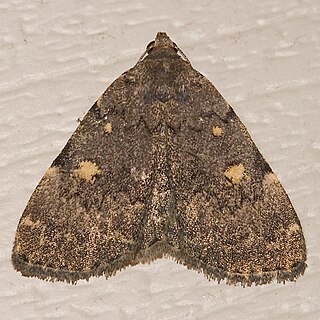
Idia aemula, the common idia, powdered snout or waved tabby, is a litter moth of the family Erebidae. The species was first described by Jacob Hübner in 1813. It is found from Canada south to Florida and Texas. It has been reported in the Palearctic.

Anavitrinella pampinaria, the common gray, is a moth of the family Geometridae. The species was first described by Achille Guenée in 1857. It is found in most of North America except the Arctic regions, south to Mexico.

Hellula rogatalis, the cabbage webworm, is a moth of the family Crambidae described by George Duryea Hulst in 1886. It is found from the southern United States north in the east to Maryland, New York and Ontario. It is also found in Mexico, where it has been recorded from Distrito Federal.
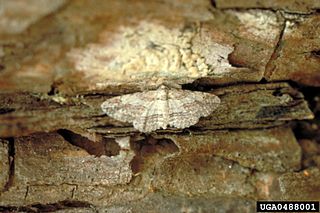
Iridopsis pergracilis, the cypress looper moth, is a moth of the family Geometridae. The species was first described by George Duryea Hulst in 1900. It is found in the US from Maryland to Florida.
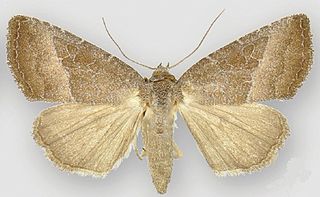
Ogdoconta cinereola, the common pinkband moth, is a moth in the family Noctuidae. It is found in eastern, central, and south-western North America. It occurs from southern Ontario and Quebec south to southern Florida. At the western edge of its distribution, it occurs from Manitoba southward through the Great Plains of Nebraska and Iowa, south throughout most of Texas, and westward through southern New Mexico to south-eastern Arizona. The distribution extends south to the state of Coahuila in northern Mexico.

Ostrinia penitalis, the American lotus borer, is a moth in the family Crambidae. It was described by Augustus Radcliffe Grote in 1876. It is found from Mexico, through Central America to Amazonas, Brazil. It is also found in North America, where it has been recorded from Quebec to British Columbia and most of the United States. The habitat consists of marshes and pondsides.

Uresiphita reversalis, the genista broom moth or sophora worm, is a moth in the family Crambidae. It was described by Achille Guenée in 1854. U. reversalis was probably native to Mexico before spreading north and becoming established in Los Angeles by 1930 and the San Francisco Bay Area by 1980. It has since been recorded across the United States and in Cuba, Bermuda, Puerto Rico and Jamaica. Both adults and caterpillars are aposematic.
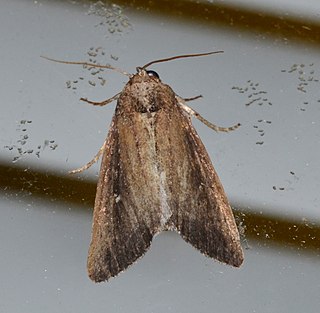
Condica videns, the white-dotted groundling moth, is a moth of the family Noctuidae. It is found in North America, where it has been recorded from Texas to Florida, north to Quebec and west to Alberta.

Elaphria chalcedonia, the chalcedony midget moth, is a moth of the family Noctuidae. It is found in North America, where it has been recorded from the eastern United States, from Maine to Florida, west to Texas and north to Wisconsin. It is also found in Jamaica, Guadeloupe, Saint Martin, Puerto Rico and Central America. It was described by Jacob Hübner in 1808.
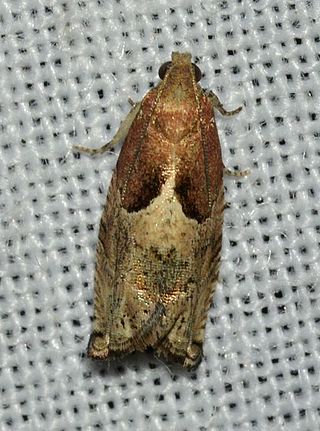
Gypsonoma salicicolana is a species of moth of the family Tortricidae. It is found in North America, where it has been recorded from Quebec to Florida, west through Texas to California and north to Alberta.
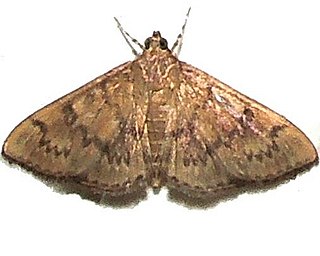
Psara obscuralis, commonly known as the obscure psara moth, is a species of moth in the family Crambidae. It is found in North America, where it has been recorded from Maryland to Florida, west to Texas and Illinois. In the south, the range extends to Central America, where it has been recorded from Mexico and Costa Rica.

Euchlaena madusaria, the scrub euchlaena moth, is a species of moth of the family Geometridae. It is found in North America, where it has been recorded from British Columbia, east to Nova Scotia, south to Florida, Missouri and Oregon. The habitat consists of dry woodlands. The species is listed as threatened in Connecticut.
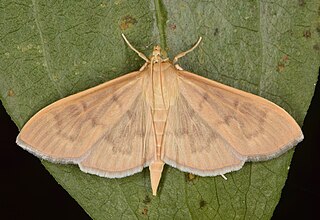
Patania silicalis, commonly known as the herbivorous pleuroptya moth, is a species of moth in the subfamily Spilomelinae of the family Crambidae. It was described by Achille Guenée in 1854. It is found in Brazil, Venezuela, Ecuador, French Guiana, Guyana, Guatemala, Costa Rica, Panama, Mexico, Cuba, Jamaica, Puerto Rico, Hispaniola and the United States, where it has been recorded from Missouri, Michigan, Ohio and New York, south to Florida.
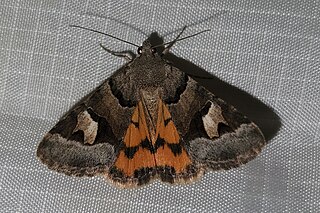
Drasteria stretchii is a species of moth in the family Erebidae. It is found in North America, where it has been recorded from northern Nevada., California, Oregon, Wyoming and Washington. The habitat consists of dry, rocky canyons at low to middle elevations.
Dichomeris citrifoliella, the orange webworm moth, is a moth in the family Gelechiidae. It was described by Vactor Tousey Chambers in 1880. It is found in North America, where it has been recorded from Michigan and Wisconsin to Florida and Texas.
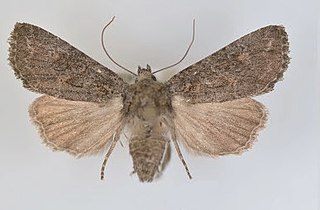
Aseptis perfumosa is a moth of the family Noctuidae first described by George Hampson in 1918. It is endemic to southern California, where it occurs in many habitats such as coastal chaparral and canyons, urban areas, brush land, and open oak forest from sea level to 2000 meters.
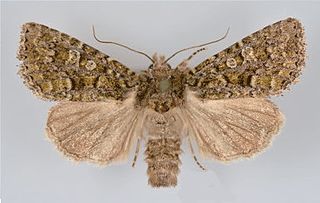
Viridiseptis is a monotypic moth genus in the family Noctuidae erected by Tomas Mustelin and Lars G. Crabo in 2015. Its only species, Viridiseptis marina, was first described by Augustus Radcliffe Grote in 1874. It is found throughout coastal California and in south-western Oregon as far north as Douglas County. It is widely distributed in southern California. It is found in many habitats such as coastal chaparral, mountain forest, mountain-desert transition zone, and occasionally in the deserts from sea level to at least 2000 meters.

Chaetaglaea rhonda is a moth in the family Noctuidae. In Canada, it is presently known only from dunes along the shore of Lake Huron in Lambton County, Ontario. In the United States, it is known from Carolina Beach State Park, New Hanover County, North Carolina. It is expected that the species occurs in suitable habitats up and down the Atlantic seaboard.

Macronoctua onusta, commonly known as the iris borer, is a species of cutworm or dart moth in the family Noctuidae. It is found in North America.



















